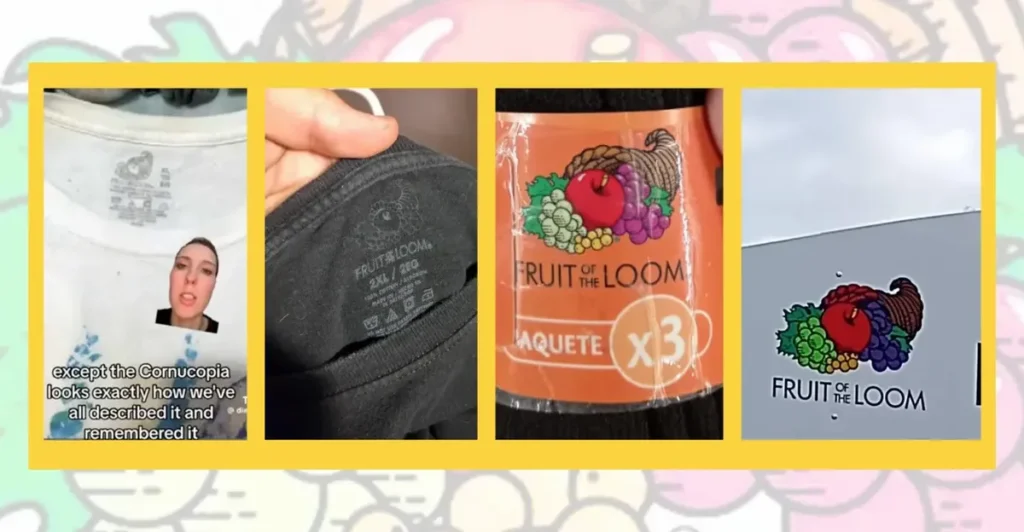In the world of branding and logos, few images are as iconic as the Fruit of The Loom logo. However, a curious phenomenon has sparked debates and intrigue: the Fruit of The Loom Cornucopia. Many people distinctly remember the logo featuring a cornucopia, despite official records showing otherwise. This article delves into the history of Fruit of The Loom, the evolution of its logo, and the intriguing Mandela Effect associated with the cornucopia.
Introduction To Fruit of The Loom Cornucopia
Logos are powerful symbols that often become deeply embedded in our collective consciousness. The Fruit of The Loom logo is no exception, featuring a vibrant array of fruits that has become synonymous with quality apparel. Yet, a peculiar aspect of this logo—the supposed presence of a cornucopia—has fueled discussions and debates. This article explores the origins of Fruit of The Loom, the evolution of its branding, and the mysterious case of the missing cornucopia.
History of Fruit of The Loom
Founding and Early Years
Fruit of The Loom was founded in 1851 by Robert Knight and Benjamin Knight in Rhode Island. Originally named the B.B. and R. Knight Corporation, the company specialized in producing high-quality textiles. The name “Fruit of The Loom” was inspired by an artist’s depiction of fruit, symbolizing the company’s commitment to quality.
Expansion and Growth
Over the years, Fruit of The Loom expanded its product line to include a wide range of clothing items. The brand became known for its comfortable and durable underwear, t-shirts, and casual wear, gaining a loyal customer base.
The Iconic Logo: Evolution and Elements
Early Designs
The earliest versions of the Fruit of The Loom logo featured a simple design, with an emphasis on the brand’s name. Over time, the logo evolved to incorporate colorful images of fruits, including apples, grapes, currants, and leaves.
Modern Logo
Today’s Fruit of The Loom logo is instantly recognizable, with its vibrant depiction of assorted fruits. However, one element that has sparked considerable debate is the cornucopia. Despite many people’s vivid memories of the logo including a cornucopia, official records and historical logos show no such element.
The Cornucopia Controversy
The Mandela Effect
The phenomenon of the Fruit of The Loom cornucopia is often cited as an example of the Mandela Effect. This term refers to a collective false memory, where a large group of people remembers something differently from how it occurred. In this case, many people recall the Fruit of The Loom logo featuring a cornucopia, despite no official version ever including it.
Possible Explanations
Several theories attempt to explain the Mandela Effect in this context. Some suggest that the cornucopia is a logical addition in people’s minds due to the association of fruit and cornucopias. Others believe that similar logos or images seen in childhood might have influenced these memories.
Impact on Branding and Public Perception
Brand Recognition
The Fruit of The Loom logo is a testament to the power of branding. Despite the cornucopia controversy, the logo remains one of the most recognizable in the apparel industry. This phenomenon highlights how logos can become deeply ingrained in public consciousness.
Consumer Reactions
The cornucopia debate has generated significant interest and discussion among consumers. This interest can serve as a testament to the strong connection people feel to the brand and its imagery, even leading to increased engagement and brand loyalty.
Analyzing the Cornucopia Effect
Psychological Factors
The Mandela Effect, including the Fruit of The Loom cornucopia case, can be partly explained by psychological factors. Memory is not a perfect process, and it is influenced by various cognitive biases and external stimuli. Over time, collective memories can merge, leading to widespread false recollections.
Cultural Impact
Cultural factors also play a role in how we remember brands and logos. Fruit of The Loom’s long-standing presence in the market and its advertising campaigns have cemented its imagery in popular culture, making any perceived changes more significant to the public.
Conclusion
The Fruit of The Loom cornucopia controversy is a fascinating example of the Mandela Effect and the power of collective memory. While the official logo has never included a cornucopia, the widespread belief in its existence speaks to the deep connection consumers have with the brand’s imagery. Understanding this phenomenon not only sheds light on the complexities of memory but also underscores the enduring impact of effective branding.
FAQs
Did the Fruit of The Loom logo ever have a cornucopia?
No, official records and historical logos of Fruit of The Loom have never included a cornucopia. The cornucopia is a common false memory associated with the brand.
What is the Mandela Effect?
The Mandela Effect is a phenomenon where a large group of people remembers something differently from how it actually occurred. It is named after the false memory many people had of Nelson Mandela dying in prison in the 1980s.
Why do so many people remember the cornucopia in the Fruit of The Loom logo?
Several factors contribute to this collective false memory, including the association of fruit with cornucopias and the influence of similar imagery seen in childhood.
How has the cornucopia controversy impacted Fruit of The Loom?
The controversy has generated significant interest and discussion, which can lead to increased engagement with the brand. It also highlights the strong connection consumers have with the brand’s imagery.
Is the current Fruit of The Loom logo different from the original?
The logo has evolved over time, but it has consistently featured a depiction of assorted fruits. The core elements have remained the same, with updates to design and color for modern appeal.
What are some other examples of the Mandela Effect?
Other examples of the Mandela Effect include the false memory of the Berenstain Bears being spelled as “Berenstein Bears” and the famous quote from Star Wars, often misquoted as “Luke, I am your father” instead of the correct “No, I am your father.”



